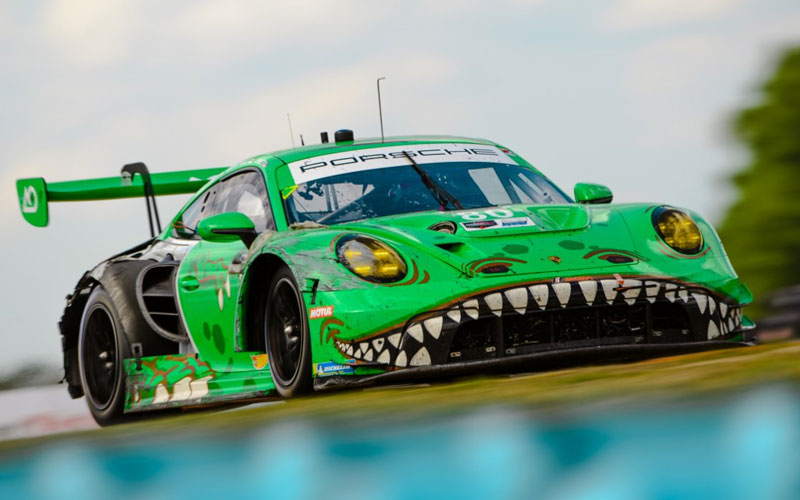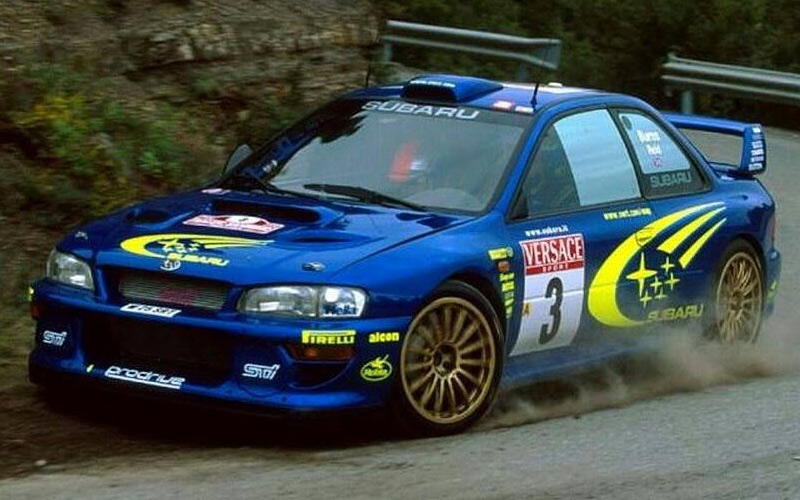15 of the Greatest Racing Liveries of All Time
We take a look at the most beloved race cars of all time. From NASCAR greats to rally champions, here are our top picks.
What’s a Race Car Livery?
A livery in motorsports is the unique exterior design covering a race car that helps identify the team, driver, and/or main sponsorship. Liveries have been a major part of motorsports history and have helped fans identify their driver amongst the rest of the grid as the cars speed around the track. We looked out across the motorsports landscape and identified fifteen of the greatest racing liveries of all time. Check out these iconic designs from NASCAR, F1, WRC, and more!
Jeff Gordon #24 Dupont Rainbow

Jeff Gordon was known for some of the most interesting car designs in NASCAR history. Gordon’s #24 car has worn everything from flames to Megatron to a lightspeed inspired Star Wars design. But the NASCAR legend’s most iconic livery has to be his classic Dupont “Rainbow Warriors” design. This vibrant rainbow design was not only impotent as it was used for his rookie year in the cup series, but it was the very design Gordon wore during his ‘95, ‘97, and ‘98 Cup Series Championship wins.
1973 BMW 3.0 CSL

BMW has some of the most beautiful liveries in motorsports history thanks to their employment of traditional artists starting back in 1975. These BMW Art Cars combined the eye-catching nature of the art world with the elegance and motion of motorsports. While each of these Art Cars are iconic in their own rights, it’s actually BMW’s own livery that makes the list. BMW’s iconic blue, purple, and red striped, white bodied design debuted on the championship winning 1973 BMW 3.0 CSL and started a history of German touring dominance that continues today. This design is still prevalent today in both BMW’s motorsports teams and is synonymous with the BMW M brand of performance vehicles.
Alitalia Lancia Stratos HF

The Stratos was a rear mid-engined Italian sports car designed by Lancia purely for dominating the rally racing world. Lancia entered their new rallying beast into Group 4 competition featuring a white, red, and green livery made to match the cars sponsorship from Alitalia Italian Airlines. The Stratos went onto secure a three-peat World Rally Championship run between ‘74 and ‘76 further cementing this livery into WRC history.
AO Racing Rexy Porsche 911 GT3 Rawrs

AO Racing has quickly grown to be a fan favorite race team thanks to their fun and friendly approach to the motorsports world. Their cars carry scaley, kid friendly designs when they participate at IMSA, Le Mans, and FIA World Endurance Championship events. AO Racing’s most popular car has to be “Rexy”, a green Porsche 911 GT3 R(awr) that’s been given a T-Rex inspired livery. Rexy made its way into the 24 Hours of Le Mans in its first year and went on to secure championship titles for IMSA and European Le Mans Series the following year Rexy was soon followed by “Roxy”, which is a pink copy of their Porsche, and “Spike”, an LMP2 car that’s livery is a purple dragon.
Martini Racing Lancia Delta HF Integrale

Lania entered their Delta HF Integrale to the Group A rally car competition in 1987. This unassuming hatchback went on to dominate the WRC world for the next six seasons, securing the ‘87 to ‘92 Constructors’ Championships and four Drivers’ Championships over the course of that same period. Throughout this WRC history making run, the Lancia wore the now well-known Martini Racing livery – light-blue, black, and red stripes on a white body.
Tommi Makinen Mitsubishi Lancer Evo

The Mitsubishi Lancer Evolution’s success in the automotive world was directly tied to the car’s dominance it imposed on the WRC world in the late ‘90s and early 2000s. Tommi Mäkinen drove the Lancer Evo to four straight drivers’ championships between ‘96 and ‘99. While he carried his white Ralliart livery through a majority of this period, it was the design started in ‘99 that lives on as one of his most famous designs – albeit due to some infamy. The ‘99 season is when Marlboro sponsored the Mitsubishi rally car and introduced the iconic red chevron livery. This car couldn’t always display the cigarette brand’s sponsorship due to rules or laws, so the team either left the Marlboro chevron on the hood empty to imply the sponsor’s logo or even cheekily replaced “Marlboro” with “TOMMI” for some events.
Porsche 959 Rothmans

Porsche only participated in rally racing in official capacity a handful of times, but its first purpose-built rally car made a significant impact on motorsports. Porsche introduced their AWD powerhouse known as the 959 and prepared it for grueling off-road terrain of the 1984 Paris-Dakar rally – where it won. Rothmans, the British tobacco brand, had sponsored Porsche vehicles since 1982 with the Le Mans winning Porsche 956. Both the 956 and 959 carried the same blue, gold, and red striped livery during their rises to fame.
Richard Petty #43 STP

The Petty blue #43 is a NASCAR icon alone but add in the STP sponsorship with some red accent stripes and you have one of the most recognizable liveries in American motorsports. Richard “The King” Petty is one of the greatest NASCAR drivers ever and his blue and red #43 STP sponsored Dodge Charger comes only second to his Plymouth Superbird car. The STP liveried Charger took Petty to his fourth Winston Cup Championship and stuck with him till his final race in 1992.
McLaren F1 Marlboro

Marlboro had a heavy hand in the motorsports world, so it’s no wonder that the brand would make its way twice on this list of liveries. Before McLaren donned the orange livery we know today, they were mostly known as the Marlboro sponsored cars of the ‘80s. The red and white MP4 series of F1 cars took home multiple Drivers’ Championships with the likes of Niki Lauda (‘84), Alain Prost (‘85, ‘86, ‘89), and Ayrton Senna (‘88, ‘90, ‘91) behind the wheel.
Ford GT40 Gulf

One of the most recognizable liveries in 24 hours of Le Mans history has to be the Gulf Ford GT40 MKI. The orange racing striped light blue car won the ‘68 and ‘69 Le Mans events and it’s been a classic livery ever since. Now that same livery can be found adorned on everything from a Ford Mustang to a McLaren Artura.
Toyota Celica GT-Four Castrol

While the Toyota Celica GT-Four’s rallying dominance is shrouded in infamy after their turbocharger cheating scandal, the Castrol livery still remains as a top design regardless. The AWD homologation special dominated Group A competition in the early ‘90s thanks to its groundbreaking anti-lag technology. Carlos Sainz piloted the green, red, and white Castrol Celica first from ‘89 to ‘92 followed by Juha Kankkunen in 1993 and Didier Auriol in 1994. Regardless of the driver, it was up on the top of the podium – until Toyota got caught and subsequently banned. Still a great looking car though.
Subaru Impreza WRX STI

Subaru’s factory team has gone through a number of different liveries for their rally cars, but the group always seems to return to their roots with the that blue and highlighter yellow paint scheme. This was originally a part of a sponsorship with a tobacco brand known as State Express 555, but Subaru kept the livery for themselves after they dropped the brand. That classic paint scheme is synonymous with Subaru’s greatest rallying years when they won multiple Constructors’ and Drivers’ championships in the late ‘90s and early 2000s.
Oracle Red Bull F1 Livery

Red Bull has some of the best motorsport liveries no matter the vehicle they sit on it seems, but the Oracle Red Bull F1 Liveries always hit since the RB16 generation. The deep blue with the red and yellow accent striping and the charging bull looks great in comparison to the rest of the grid. It’s truly a perfect livery to represent possibly the greatest driver we’ve ever seen do it, Max Verstappen.
Ironman Stewart Toyota Trophy Truck
You may not remember the name, but everyone recognizes the truck. Ivan “Ironman” Stewart made waves with his Toyota TRD sponsored Trophy Truck. This white truck featuring the now well-known TRD red, orange, and yellow livery made waves by winning off-road events throughout the ‘90s and is known by many outside the motorsport world through Toyota’s marketing or via the Super Off Road arcade cabinet from back in the day. Ironman is one of the most decorated off-road racers to ever do it having won three Baja 1000s, 17 Baja 500s, and numerous other off-road racing events. While Ironman has since retired, his iconic trophy truck has continued to stand out as the pinnacle of Toyota Racing Development and one of the greatest designs to race.
Dale Earnhardt #3 Goodwrench

Sometimes a simple livery is made great just because of the driver it’s associated with. Dale Earnhardt Sr. was one of the greatest to ever do it when it comes to NASCAR. He was given plenty of nicknames like “The Intimidator”, “Ironhead”, and “The Man in Black”. That last one is what made Senior’s Goodwrench #3 livery one of the best. His all-black stock car with silver and red accent stripes wasn’t looking to standout because it didn’t need to. That black #3 was gunning for the win and he’d teach a rookie a thing or two if they tried to get past him. The #3 car will live on in NASCAR fans’ hearts as a remembrance of one of the best, taken too soon.










